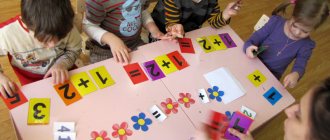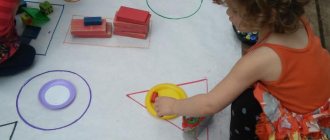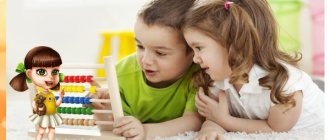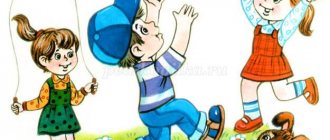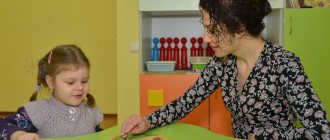Summary of a lesson on the formation of elementary mathematical concepts on the topic: “Oval”
Attached to each carriage is a card with a picture made up of geometric shapes drawn on the tickets:
— I am a cashier at a railway ticket office. Each of you will receive a ticket. Then you need to find your carriage. To do this, take a close look at your tickets. If you find the same geometric shapes on the carriage, then this carriage is yours.
While the children are looking for their seats, the teacher takes on the role of conductor (puts on a cap, takes a bag, attaches a badge). The children get into their carriages.
— Has everyone taken their seats? (Yes).
- Now I am a conductor. Show your tickets.
The teacher checks the “tickets”.
Subtotal:
Well done guys, everyone managed to get on the train because they correctly identified the geometric shapes. We can go.
The audio recording “Knock of Wheels” is played.
- Guys, we've arrived!
3. Difficulty in a game situation.
Goal: organizing an analysis by children of the situation that has arisen, leading them to identify the location and cause of the difficulty.
Requirements:
- creating a situation of difficulty;
- fixation in speech of the cause of the difficulty.
Children are “met” by the inhabitants of the country of Geometric shapes (triangle and square). Under the magnet next to them is a piece of paper with a task.
— Guys, do you think the inhabitants of the country of Geometric Shapes are happy to see us? (Yes).
- How did you guess? (They smile at us).
- Of course, the residents are happy, because you came to help them!
- Let's ask the residents how to help them! (The children ask, but the circle and square are silent).
- Learned? (No)
— How do you know how to help residents? (Guess), (See for yourself what needs to be done), (Read what is written in the note).
The teacher reads the note:
“Put things back where they belong, in boxes.”
Game "Putting objects in place"
The children sit at the tables. On the tables there is a “box” (a large circle) and “things” - round-shaped objects: a wheel, a watch, a plate, a coin, a tray, a sponge, a steering wheel, cookies, a steering wheel, a CD, a cutting board, a lifebuoy. The size of the small circles is such that they fit into an oval. There are also oval-shaped objects according to the number of children - a watch, a mirror, a piece of bread, a tray, a plate, a sponge, a napkin, a wooden cutting board, a plastic cutting board, a rug.
— What shape is the box? (Round).
- This means that round objects must be put in it.
— Put these items in the box. (the teacher points to a circle cut out of a landscape paper)
Children place round objects in a circle, but cannot place oval objects.
— Are all things in place now? (No).
—You couldn’t put all your things away? (Failed).
- Why? What's the problem? (There are things that are not round, the mirror does not fit into the box).
- Why can't we put these things in a round box? (Because it is of a different shape; the napkin is not round).
“You couldn’t remove all the things and help the residents.”
The teacher pauses long enough for the children to comprehend the situation of difficulty.
—Are you in a difficult situation? (Yes).
- Discovery of new knowledge.
Goal: organizing a dialogue between the teacher and children aimed at discovering new knowledge.
Requirements:
- organizing an introductory dialogue in order to discover new knowledge;
- fixation of new knowledge in speech and symbolically;
- creating a situation of success.
Game "Find the box"
- What do we do? (Let's pick a box for these items).
If the children find it difficult, the teacher continues the introductory dialogue:
— You put round objects in a round box. Items that you were unable to remove have a different shape. Can you find a suitable box for it? (Yes).
- Pick it up.
Children go to another table, on which there are squares, triangles, circles and ovals cut out of colored cardboard. There are as many ovals as there are children.
— Guys, choose a suitable box and put the items in it.
Children choose the desired “box” and sit down.
— Now all the items are put away in boxes? (Yes).
- Count how many round objects you have? (Four).
— How many non-round objects do you have? (One).
Subtotal:
Well done, you managed to tidy up because you picked suitable boxes for both round and oval items.
The teacher tells the children that the inhabitants of the country of Geometry thank them and give them a gift - a box with ovals. Children each take an oval,
The teacher hangs an oval on the board.
- Do you want to play with them? (Yes)
- Look at the oval.
- Circle it with your finger (children circle the oval).
-What did you notice? (an oval has no corners)
- What other figure does not have corners? (at the circle)
— How does an oval differ from a circle (an oval is elongated, and a circle is smooth)
We know that the circle rolls well (the teacher shows how the circle rolls)
— Try to roll an oval (children roll an oval).
— The oval also rolls well (no).
- Let's hide the oval (children “hide” the oval under a sheet of paper)
The teacher shows the ellipsoid.
- Is this an oval? (Not really)
- Let's try to hide it (the children are trying to hide the ellipsoid under a sheet of paper).
— Did you manage to hide this figure? (No)
- That's right, this figure is not an oval, an oval is flat.
The teacher points to the oval.
- Here is an oval - it is flat, elongated, without corners.
Summary: Well done guys, you understand what an oval is.
5. Inclusion of new knowledge into the knowledge system.
Goal: consolidate new knowledge in children through games and exercises.
Requirements:
- compliance of the games used with the purpose of the lesson;
- individual difficulties in games;
- situation of success in joint activities.
A rectangle appears with a sad face on it. He has a note.
— Another resident came to us. What do you think is his mood? (he is sad, cheerless)
- Ask why he is so sad?
- Why are you so sad?
(The children ask, but the rectangle is silent.)
- Learned? (No)
- How to find out? (Guess, read what is written in the note).
The teacher reads the note:
“I lost oval objects because I was lazy and didn’t put them back in their place.”
- Don’t worry about the rectangle, our guys will help you.
- Guys, can you help? (Yes)
Game "Collect objects"
The teacher is holding an oval-shaped box in his hands.
- Look carefully around, find all the oval-shaped objects in our group and bring them to this box.
Children look for oval objects laid out everywhere in a group (mirror, rug, sponge, napkin, etc.)
Subtotal:
Well done boys. You completed the task and found all the lost oval objects.
When children find all the oval objects, they give the box to the rectangle. The rectangle has a joyful face. He has a note.
- Look, guys, another note. Let's read it.
The teacher reads the note:
"Thank you guys. I will never throw my things around again. Because you helped me, I want to give you a cartoon.”
Children watch the cartoon "Geometric Shapes".
— Guys, did you like the rectangle gift? (Yes)
“Now it’s time for us to go back to kindergarten.” Take your seats on the train.
The sound of wheels sounds in the recording, the children return to kindergarten.
- Summary of the lesson.
Goal: organizing reflection and self-assessment of children’s activities.
Requirements:
- organization of analysis of children's goals;
- fixation of new knowledge in speech;
- determining the fulfillment of an adult goal.
Children sit on chairs.
- Guys, where were we today? (in the country of Geometry)
- Why did we go there? (help residents clean up)
— Were we able to help the inhabitants of the country of Geometry? (Yes)
- Why did you succeed? (we know geometric shapes, we know colors, we can count, we are kind)
- What geometric shape did we meet today? (oval)
“We completed all the tasks because we know geometric shapes, we know colors, we can count, because we are attentive, kind guys. Well done!
Lesson on FMP in the middle group on the topic “Introduction to the number 2. Short, long, oval.”
Summary of an open lesson on FEMP in the middle group on the topic “Introduction to the number 2. Short, long, oval.”
Program content: Introduce children to the number 2; learn to determine the position of the number 2 among the number line; consolidate the ability to find number 2 among other numbers; consolidate the ability to compare familiar objects by size, length (long, short); consolidate knowledge about the geometric figure “oval”, the ability to find it among many figures; cultivate a sense of mutual assistance and accuracy. Equipment and materials: toys - camel and baby camel, workbook No. 1. Preliminary work: while walking, collect bouquets of two leaves, play the game “On a narrow path.” Vocabulary work: short, long, oval. Bilingual component: eki-two, t?ye – camel, sopa?sha – oval. Progress of the lesson: A surprise moment. A baby camel came to visit. He lost his mother, but if the guys guess the riddles, then the camel’s mother will definitely come for the baby camel.
I'm asking a riddle:
“A camel walks in the steppe. How sad it is to be alone on the road But his son came up to him And he is no longer alone.” I invite the children to complete a task in their workbook: fill in as many circles in the rectangle under the picture as there are camels walking in the steppe. I ask how many circles were painted in? A camel appears, takes the baby camel, and they leave. I read a poem to the children about the number two: “The two arches its neck, lets its tail go. How can she not swim on the waves, But she can always be second!” Let's memorize a poem. Are we working in workbooks? Children determine the place of the number on the number line, find all the twos among the other numbers and circle them, as shown in the figure. I’m conducting physical education “Maple”. The wind quietly shakes the maple tree, tilts left and right, tilt once and tilt twice. The maple leaves rustled. I invite the children to work in workbooks. Color the largest oval with a green pencil, the smaller one with blue, and the smallest one with red. I ask: how many ovals were painted over? what size are the ovals? I read a poem: On a very hot summer day.
The camel was going to water.
Help him quickly
Get to the water faster.
Don't waste your time,
And choose the road. I give the task to paint the long road yellow, and the short road green. I ask questions: how long is the yellow road? how long is the greenway? Which road will the camel get there faster? I do individual work. We repeat the words in the Kazakh language. We carry out self-monitoring and self-assessment of the work performed. Reflection: what did you like about the lesson? How many ovals did you paint?
Text of the book “Drawing with children 4-5 years old. Class notes"
Daria Nikolaevna Koldina Drawing with children 4–5 years old. Class notes
From the author
Visual activity (drawing, modeling and applique) is one of the most important means of understanding the world and developing aesthetic perception, associated with the independent practical and creative activity of the child.
Teaching visual arts in preschool age involves solving two main tasks:
• awaken in children positive emotional responsiveness to the world around them, to their native nature, to life events;
• to develop children's visual skills and abilities.
In the process of visual activity, preschoolers improve their powers of observation, aesthetic perception and emotions, artistic taste, and creative abilities.
It is also advisable to introduce preschoolers to non-traditional drawing techniques, which can also become means of expression. Therefore, in this book we provide notes on exciting lessons in painting with gouache and watercolor paints, colored pencils and wax crayons in traditional and non-traditional ways.
The classes are organized according to the thematic principle: one topic unites all classes (on the surrounding world, on speech development, on modeling, on appliqué, on drawing) during the week.
Drawing classes for children 4–5 years old are held once a week; Lesson duration 15–20 minutes. The manual contains 36 notes of complex lessons designed for the academic year (from September to May).
Read the lesson notes carefully in advance and, if something doesn’t suit you, make changes. Prepare the necessary material and equipment. Preliminary work before class is also important (reading a work of art, becoming familiar with surrounding phenomena, looking at drawings and paintings). It is advisable to conduct a drawing lesson after the children have already sculpted and completed an application on this topic.
Drawing classes are structured according to the following approximate plan:
• creating interest and emotional mood (surprise moments, poems, riddles, songs, nursery rhymes, familiarity with works of fine art, reminders of what was seen earlier, a fairy-tale character in need of help, dramatization games, exercises for the development of memory, attention and thinking; active a game);
• the process of work begins with examining and feeling the depicted object, advice from the teacher and suggestions from children on how to complete the work, in some cases showing depiction techniques on a separate sheet. Next, the children begin to create works. The teacher can show the children a successfully started drawing and guide the actions of the children who need support and help. When finalizing a drawing with additional elements, you need to draw children’s attention to expressive means (correctly selected colors and interesting details);
• examination of the received work (children's drawings are given only a positive assessment). Children should be happy with the result obtained and learn to evaluate their own work and the work of other children, notice new and interesting solutions, and see similarities with nature.
Children 4–5 years old consciously approach the drawing process and strive to achieve the desired result. Their drawings usually depict single objects. Children draw an object in parts - first the largest parts, then smaller ones and some characteristic details. The guys gradually begin to combine several objects in one drawing, creating a plot composition; learn to choose appropriate colors. They develop strong skills in proper use of a pencil and brush.
For drawing classes you will need: drawing paper and watercolor paper, gouache paints, watercolor paints, pencils, colored pencils, felt-tip pens, wax crayons, soft and hard brushes, cotton swabs, glasses of water, wide bowls for diluting gouache, palettes, oilcloth linings, rags.
Let us list some properties of visual materials.
Gouache
gives a durable opaque layer; as it dries, you can layer one layer on top of another. Gouache paints are slightly diluted with water to pick up the paint on the brush bristles. To obtain a new color, you need to mix the primary colors, and to obtain lighter tones, white is added to the paints. Gouache can be painted on white and colored paper.
Watercolor -
delicate, light, transparent colors. Watercolor paints, like gouache paints, can be mixed to create a new color. A lighter tone is obtained by diluting the paint with water. To paint with watercolors, children should be given special, rough watercolor paper.
Colour pencils
have thick rods containing fatty particles. Their oily, shiny marks adhere firmly to any paper. When drawing, you need to press evenly on the pencil, put strokes in one direction, without gaps or dark spots. Do not use colored pencils for coloring large surfaces. It is advisable to draw with them on half of the album sheet.
Markers
filled with special ink. They give a bright, rich color. It is easier for children to draw with felt-tip pens than with pencils because felt-tip pens easily leave a mark on paper, but when drawing with felt-tip pens, you cannot get shades of color. It is advisable to draw with felt-tip pens on drawing paper.
Wax crayons
They have rich, bright colors and can be used to paint over a surface much faster than with colored pencils. By changing the pressure, you can get different tones of the same color. Wax crayons are suitable for drawing on paper, cardboard, glass and metal.
Expected skills and abilities of a child by age five:
• shows interest in drawing with different materials and methods;
• knows how to depict simple objects.
• has an idea of the shape of objects (round, oval, square, rectangular, triangular), size, location of their parts;
• knows how to create a simple plot composition from repeating and different objects;
• creates a plot composition from objects, adding various objects to them (sun, rain, snow);
• places the plot on the entire sheet of paper;
• knows how to mix paints of primary colors to obtain orange, purple, green, brown colors and knows how to choose the right colors to depict objects;
• knows how to obtain shades of colors (pink, blue, light green) by mixing gouache with white;
• uses a variety of colors in drawing;
• obtains the brightest or lightest shades by adjusting the pressure on the pencil;
• correctly holds a brush, pencil, felt-tip pen, colored greasy chalk;
• picks up paint only onto the bristles of the brush; to pick up paint of a different color, rinse the brush well in a jar of water, remove excess water with a cloth or on the edge of the jar;
• knows how to draw wide lines with the whole brush, and use the tip of the brush to put dots and draw thin lines;
• continuously paints within the outline with colored pencils, applying strokes in one direction;
• paints over the drawing, drawing lines in one direction; rhythmically applies strokes without going beyond the contour;
• correctly conveys the location of parts when drawing complex objects and correlates them by size;
• familiar with non-traditional drawing techniques (fingers, palm, poking with a hard, semi-dry brush, drawing with wax crayons and watercolors), can make imprints of leaves, create an image on a wet sheet, make an imprint with crumpled paper;
• keeps his workplace in order;
• creates a composition based on Dymkovo patterns;
• creates a composition based on Filimonov patterns;
• familiar with Gorodets products, elements and color combinations of Gorodets painting.
Annual thematic planning of drawing classes
Class notes
Topic of the week: “Parts of the body and face”
Lesson 1. There are such boys (Drawing with a simple pencil)
Program content.
Teach children to draw a happy and sad face with a simple pencil. Learn to analyze and understand the content of a poem. Cultivate a friendly attitude towards others. Learn to express and describe your feelings.
Material.
Landscape sheets, simple pencils (for each child).
Progress of the lesson
Read excerpts from A. Barto’s poem “There are such boys” to the children:
We look at the boy - He’s kind of unsociable! He frowns and sulks, as if he drank vinegar. We thought and thought, We thought and came up with: We will be, like Vovochka, Gloomy, gloomy. We went out into the street - They also began to frown. He looked at our faces, He was about to get angry, Suddenly he burst out laughing. He doesn't want to, but he laughs louder than a bell.
Ask the children:
– What was the boy like at the beginning of the poem? (Gloomy, angry, sad.)
– What did he become at the end of the poem? (Cheerful, kind, laughing.)
Invite the children to portray first a sad boy, and then a cheerful one. To do this, you need to draw a circle on the left half of the sheet - a face, eyebrows in the form of downward arches and a mouth, with the corners of the lips downward. On the right side of the sheet you need to draw a circle - a face, straight eyebrows and a smiling mouth with the corners of the lips raised up.
At the end of the lesson, ask the children when they feel sad and when they feel happy.
Theme of the week: “Vegetables”
Lesson 2. Cucumber and tomato (Drawing with colored pencils)
Program content.
Teach children to draw round and oval objects from life and paint them with colored pencils, without going beyond the outline and applying strokes in one direction. Learn to draw objects large, placing them on the entire sheet. Develop sensory sensations. Learn to distinguish and name vegetables.
Material.
Dummy vegetables (cucumbers and tomatoes), bag. Halves of album sheets, colored pencils.
Progress of the lesson
Together with the children, name, examine and feel the vegetables (models), and then put them in the bag. Next, the children will take turns looking for a vegetable in the bag, naming it, and only then taking it out.
Invite the children to carefully look at the cucumber and tomato again. Determine their shape (oval and circle) and color (green and red). Next, children draw these vegetables on a sheet of paper and color them in with colored pencils. Remind the children that strokes should be placed in one direction, without gaps, and try not to go beyond the outline of the object; It is also important to ensure that the vegetables are large and spread over the entire sheet.
At the end of the lesson, ask the children what other vegetables can be drawn.
Theme of the week: “fruit”
Lesson 3. Apple and pear (Brush painting. Gouache)
Program content.
Teach children to draw round and oval objects from life with a simple pencil and paint with gouache using a brush; draw objects large, placing them on the entire sheet; Remove excess water from the brush with a cloth. Strengthen the ability to distinguish between fruits and vegetables.
Material.
Models of vegetables and fruits (or object pictures). Half landscape sheets, pencils, gouache, brushes, glasses of water, rags (for each child).
Progress of the lesson
Offer to play in the store. Children, in turn, need to approach the table where fruits and vegetables are laid out and “buy” what the adult asks: “Masha, buy a red vegetable.” Masha needs to look at the table, name a red vegetable (tomato or carrot, etc.) and take it. Then the adult asks: “Dima, buy a yellow fruit.” Dima needs to name what he chose (banana or pear, etc.) and take this fruit.
Then invite the children to draw an apple and a pear with a simple pencil, and then paint over them with gouache. After dipping the brush into the water, you need to blot it with a cloth to remove excess water. And excess paint from the brush needs to be removed on the edge of the jar with gouache. It is also important to ensure that the fruits are large and spread over the entire sheet.
At the end of the lesson, ask what other fruits you can draw.
Theme of the week: “Berries”
Lesson 4. Cherry branch (Drawing with colored pencils)
Program content.
Teach children to draw and color a branch with berries with colored pencils; place the drawing on the entire sheet. Learn to understand and analyze the content of the poem.
Material.
Half landscape sheets, colored pencils (for each child).
Progress of the lesson
Start the lesson by reading G. Boyko’s poem “Cherry”:
In early spring this year I planted my own cherry tree. Now look: Overtaking me, My cherry has grown over the summer.
Ask the children:
– At what time of year did the girl plant the tree? (In early spring.)
– What was the cherry tree like at first? (Small.)
– Did the cherry tree grow quickly? (Yes – I grew up over the summer.)
Offer to draw the berries that are ripe on this tree. Show on a separate sheet of paper how to first draw two branches connected at the top and diverging downwards in different directions, and at the end of each branch draw circles - berries. On the side of the branch, draw an oval sheet of dots. Children draw a cherry according to this pattern and color it in with colored pencils.
Theme of the week: “In the forest”
Lesson 5. Mushroom (Brush painting. Gouache)
Program content.
Teach children to draw from life objects consisting of an oval and a semi-oval; create a simple plot composition. Strengthen the ability to remove excess water on the brush with a cloth. Continue learning to imitate movements in accordance with the text of the poem.
Material.
Dummy mushroom. Halves of album sheets, simple pencils, gouache, brushes, jars of water, rags (for each child).
Progress of the lesson
Invite the children to go for a walk in the forest. Stand one after another and quietly “walk through the forest.” Ask the children: “What can we see in the autumn forest?” (Trees, bushes, berries, mushrooms.)
Offer to recite a poem and pretend to pick mushrooms. You need to slowly walk through the forest, bend down and put mushrooms in an imaginary basket:
The children walked and walked and walked and found a white mushroom. One - fungus, Two - fungus, Put it in the box.
Ask the children what a box is. (Basket.)
Invite each child to draw one mushroom. Examine a dummy mushroom with your children and determine that it has a stem and a cap.
First, children draw an oval leg with a simple pencil, a semi-oval cap on top and paint over it with gouache. Remind the children that after dipping the brush into the water, they need to blot it with a cloth to remove excess water; Excess paint from the brush must be removed on the edge of the jar with gouache.
Tell the children what they can add to the drawing: draw a sun, grass in which a mushroom grows.
Theme of the week: “City Birds”
Lesson 6. Dymkovo birds (Brush painting. Gouache. Team work)
Program content.
Cultivate interest in the art of Dymkovo masters. Teach children to highlight and draw with the tip of a brush the elements of Dymkovo painting (rings, dots, sticks, wavy lines). Continue to learn how to remove excess water on the brush with a cloth. Develop creativity and imagination.
Material.
Clay Dymkovo toys and illustrations with their images (young ladies, horses, geese, chickens, roosters, ducks); samples of elements of Dymkovo painting. Silhouettes of clay bird toys cut out of paper, a sheet of colored paper, gouache, brushes, jars of water, rags (for each child).
Progress of the lesson
Tell the children that in the village of Dymkovo near Moscow, people came up with the idea of making funny toys out of clay and painting them with bright colors.
Show the children examples of elegant Dymkovo young ladies, dashing horses, ducks, chickens and roosters. Tell us how these toys were sculpted from clay, and then the crafts were painted with crimson, yellow, orange, blue, and brown paints.
Ask the children what patterns the craftsmen drew on clay toys (rings, dots, intersecting lines, wavy lines).
Give children painted samples and cut-out paper silhouettes of geese, chickens and roosters. Show how to draw fine lines with a brush tip.
Invite children to become Dymkovo craftsmen and make the birds elegant, decorating them with rings, dots and lines.
At the end of the lesson, create a composition of the poultry yard on a sheet of colored paper.
Topic of the week: “Migratory and resident birds”
Lesson 7. Owl (Drawing with colored pencils)
Program content.
Teach children to draw a bird using an oval and a circle. Introduce the distinctive features of an owl. Develop imagination.
Material.
Subject picture with the image of an owl; half album sheets, simple and colored pencils (for each child).
Progress of the lesson
Read the nursery rhyme to the children:
It’s dark in the forest, everyone has been sleeping for a long time. One owl does not sleep, sits on a branch, looks in all directions, and how it will fly!
Look at the picture of an owl with your children. Tell us that an owl is a big bird with huge eyes. At night she hunts mice and sleeps during the day.
Invite the children to draw an owl. To do this, you need to draw a circle (head) with a simple pencil, and draw an oval at the bottom, narrowed downwards. On the head draw large eyes, a beak, and ears. At the bottom of the oval are the paws and the branch on which the owl is sitting. When the owl is ready, you need to paint it over with an orange, yellow or brown pencil.
Theme of the week: “Autumn”
Lesson 8. Autumn leaves (Leaf prints. Gouache)
Program content.
Teach children to make prints with leaves. Learn to mix red and yellow gouache to get orange. Learn to distinguish and name trees, recognize leaves.
Material.
A landscape sheet, fallen leaves from different trees (maple, birch, rowan, poplar, oak), gouache, a wide brush, a jar of water, a sheet of paper or oilcloth (place under the leaves to be painted).
Progress of the lesson
Ask the children to bring some fallen leaves for this activity ahead of time. Read the poem by I. Evensen to the children:
Leaves are falling, falling, leaves are falling in our forest. Red and yellow leaves curl and fly in the wind.
In class, look at the autumn leaves with your children and determine which tree each leaf comes from.
Then each child takes one leaf, places it with the smooth side on the oilcloth and paints the underside of the leaf with gouache of the same color. To make an orange leaf print, teach children to mix red and yellow paints. While the gouache has not dried, the painted side of the leaf is applied to a clean sheet of paper and pressed tightly so that it is printed in its entirety. The leaf cannot be moved.
This way the child can make several prints of different leaves. At the end of the lesson, ask the children how many leaves each of them drew.
Theme of the week: “Dishes”
Lesson 9. Cup (Drawing with cotton swabs. Gouache)
Program content.
Teach children to draw a large piece of utensils from life with a simple pencil, placing it on the entire sheet. Learn to choose the appropriate colors yourself, trace the outline drawn in pencil with dots using a cotton swab with gouache; decorate the product with dots drawn with a cotton swab. Practice forming the plural of nouns.
Material.
Cup, plate, pan (you can take toy dishes), ball. Landscape sheets, simple pencils, cotton swabs, gouache, jars of water (for each child).
Progress of the lesson
Show the children a saucepan, a plate and a cup and ask how these objects can be called in one word. (Dishes.)
Invite the guys to play. Children stand in a circle, you throw the ball to one child and name one piece of utensils, the child throws the ball back and names many of these items. (Cup – cups.)
Then you throw the ball to another child, etc.
Invite the children to look at the cup again. Show how to draw on a piece of paper with a simple pencil a cup in the form of a rectangle, slightly tapering downward, and the handle of the cup. Then each child takes a cotton swab by one end, moistens the other end in water and puts gouache of the desired color on it. Trace the pencil outline with dots. You can make imprints on the cup in the form of dots on the tips of a cotton swab. You can use different paints, but carefully rinse the tip of the cotton swab.
Theme of the week: “Food”
Lesson 10. Candy (Drawing with colored pencils)
Program content.
Continue teaching children to draw round and oval objects. Develop creativity and imagination. Learn to understand and analyze the content of the poem.
Material.
Half of the album sheets, simple and colored pencils (for each child).
Progress of the lesson
Read to the children an excerpt from S. Mikhalkov’s poem “Sweet Tooth”:
There is no greater joy in childhood, seeing these sweets, sitting closer to them and eating everything you see. Pounce and eat!
Ask the children what sweets they would like to eat. (Candy, cakes, ice cream, etc.)
Invite the children to draw sweet, tasty round and oval-shaped candies; decorate their candy wrappers so that you immediately want to eat these candies.

